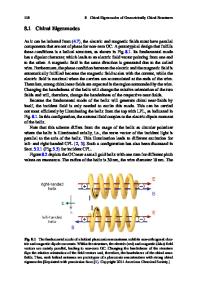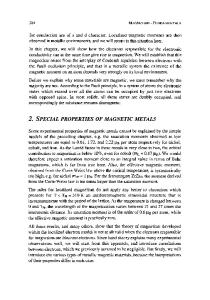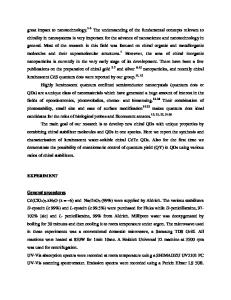Itinerant Chiral Magnet MnSi
- PDF / 2,307,322 Bytes
- 7 Pages / 612 x 792 pts (letter) Page_size
- 20 Downloads / 428 Views
ant Chiral Magnet MnSi S. M. Stishova,b,* and A. E. Petrovaa,b,** a
Institute for High-Pressure Physics, Russian Academy of Sciences, Troitsk, Moscow oblast, 108840 Russia b Lebedev Physical Institute, Russian Academy of Sciences, Moscow, 119991 Russia *e-mail: [email protected] **e-mail: [email protected] Received January 20, 2020; revised January 20, 2020; accepted March 6, 2020
Abstract—A brief overview of the results of experimental studies of the magnetic phase transition in the chiral MnSi magnet is given. Evidence for the fluctuational nature of the first-order phase transition in the magnet under study is provided. The nature of the secondary maximum in the curves describing the behavior of the specific heat, the thermal expansion coefficient, the temperature derivative of the electrical resistivity, and the sound absorption is discussed. The situation related to the manifestation of quantum critical behavior in MnSi and (MnFe)Si at low temperatures is analyzed. DOI: 10.1134/S1063776120070134
completeness of references, especially since there is quite an extensive review literature on this issue [4–6].
1. INTRODUCTION In 1956 A.S. Borovik-Romanov and M.P. Orlova detected a weak ferromagnetic moment in a number of antiferromagnetic carbonates [1]. Slightly earlier this effect was observed in antiferromagnetic hematite. These studies attracted the attention of I.E. Dzyaloshinskii, who constructed a theory of the peculiar relativistic interaction responsible for the observed phenomenon [2]. A similar theory was also developed by T. Moriya [3]. At present, this interaction is called the Dzyaloshinskii–Moriya (DM) interaction. A dramatic manifestation of the DM interaction is the formation of helical (chiral) magnetic structures. Manganese silicide (MnSi) is a model helical magnet that clearly demonstrates the DM interaction effects. MnSi is crystallized in a B20-type cubic structure with a unit cell parameter a ≈ 4.56 Å (Fig. 1), whose space group P213 (T4) contains no inversion center. Accordingly, a relativistic DM contribution of the form D[Si × Sj] is contained in the MnSi energy, making the existence of a helical magnetic structure possible. The helical magnetic structure in MnSi is a spiral with a pitch of 180 Å and a wave vector q ≈ 0.035 Å–1 directed along [111].
2. MAGNETIC PHASE TRANSITION IN MnSi Thus, the temperature of the magnetic phase transition in MnSi at atmospheric pressure is about 29 K. Under hydrostatic pressure P the phase transition temperature Tc tends to zero at P ≈ 1.4 GPa (Fig. 2). Naturally, this raises the question about the quantum critical behavior of MnSi at T = 0, but we will discuss this situation slightly later. Figure 2 displays the P–T phase diagram of MnSi constructed from electrical resistivity, magnetic susceptibility, and thermal expansion measurements.
Significantly, MnSi melts congruently, allowing large good-quality crystals suitable for various experiments to be grown. Below we will consider the basic experimental facts that characterize the physics
Data Loading...











